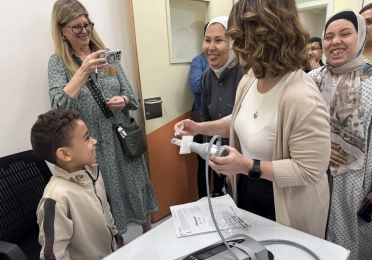The Essential Role of Bacterial Viral Filters in Safe Spirometry Testing

Infection control is at the forefront of everyone’s minds in the post-Covid era.
We are all familiar with the basics such as cleaning surfaces, disinfecting items that have come into contact with patients, and disposal of single-use items. Slogans such as “coughs and sneezes spread diseases” and the more recent “catch it, kill it, bin it” are widely used.
During the Spanish flu outbreak in 1919, the public was advised to use face coverings (Morens et al., 2021). What links us with that outbreak 100 years ago? The concept of creating a barrier to prevent the transmission of disease. This is the same principle on which bacterial viral filters work. They create a barrier to prevent pathogens entering the environment.
In healthcare settings, bacterial-viral filters (BVFs) play a critical role in preventing the transmission of airborne infections. These filters are used in respiratory devices, such as ventilators, anaesthetic machines, and breathing circuits, to prevent the spread of pathogens, including bacteria and viruses, which pose a serious threat to both patients and healthcare professionals.

What is a BVF?
BVFs act as a barrier by trapping harmful microorganisms before they can enter or as they exit a patient's respiratory system, significantly reducing the risk of infection. For example, patients with respiratory conditions like chronic obstructive pulmonary disease (COPD) or asthma may require mechanical ventilation, which increases their exposure to harmful airborne pathogens. By using ventilator filters, healthcare professionals can minimise this risk, ensuring a safer treatment environment.
Protecting Patients and Healthcare Workers
The use of BVFs is important in protecting healthcare workers who are in constant close contact with patients, especially in critical care settings. Respiratory procedures such as intubation, extubation, and nebulisation generate aerosols, which can contain infectious particles. These aerosols, if inhaled, can cause respiratory infections, making healthcare professionals vulnerable, particularly during outbreaks of highly contagious diseases such as COVID-19. During the COVID-19 pandemic, the use of BVFs gained particular attention due to their ability to reduce the transmission of the SARS-CoV-2 virus in clinical environments (Zannin et al,2021)
Infection Control
Infection control procedures are evidence-based and protect patients and staff from avoidably spreading infections. From washing your hands to wiping down equipment once you have seen the patient and every step in between, infection control is essential to ensure the safety of patients and clinicians.
Mouthpieces and nose pegs should be single patient use, with the latest ATS/ERS spirometry standards stating that the use of in-line filters has become standard practice in most testing facilities.
Cross-contamination during spirometry
Spirometry is a maximal test and is one of the few diagnostic procedures that rely fully on the patient’s effort. Although spirometry is not considered an aerosol-generating procedure (AGP), the effort required can often induce coughing, leading to droplets and aerosols being produced and spread in the testing vicinity. When a patient performs spirometry, they exhale at a much higher flow rate than during relaxed breathing, and they exhale until they are empty. During maximal manoeuvres, bacterial or viral particles may be ejected from the patient into the device and the room if there is no barrier in place to stop them.
Most spirometers on the market today are flow sensing spirometers, which means that they measure the flow of air passing through them and are open at both ends. As a result, expired air and everything in it passes into the spirometer and out the other end. This can be unpleasant for the clinician if droplets pass into or through the device.
One-way mouthpieces
The ATS/ERS statement 2019 on spirometry states that inline filters will reduce contamination of the device. One-way cardboard mouthpieces may be used to prevent cross-contamination. This may reduce the risk of user-to-user inhalation, but it does not prevent the risk of contamination of the device and the air within the room.
When thinking about the contamination of the wider environment, we can consider how long certain bacteria and viruses survive outside the body. The SARS-CoV-2 virus which causes Covid-19 can live up to three days on hard surfaces, whereas Tuberculosis (TB) can live up six months on hard surfaces, if not in direct sunlight.
Cardboard mouthpieces may appear to be the more environmentally friendly option; however, they are typically more difficult to recycle due to their thin plastic coating. They also contain different types of plastic, which presents challenges for the recycling process.
How do Bacteria Viral Filters work?
A Vitalograph Bacterial Vital Filter (BVF) will remove droplets, aerosols, bacteria, and viruses (including MRSA, TB, Influenza & SARS-CoV-2) out of the airstream with >99.999% cross-contamination efficiency. This can give added confidence that staff and patients are safe, as the majority of potentially harmful pathogens are trapped inside the filter. With the use of a cardboard mouthpiece, the potentially harmful bacterial and viral particles will simply pass through, entering the device and surrounding environment.
Cleaning guidance is provided with each device, however using a Vitalograph spirometer in conjunction with a Vitalograph BVF overcomes the need to deep clean the flow head between patients, reducing the downtime of the device. An annual service by Vitalograph is recommended, at which point the flow head is replaced.
Why should I use a Vitalograph BVF?
Using a BVF protects both the individual being tested and the test operator. BVFs also reduce the downtime required for device cleaning, allowing more time to be spent helping patients to give their best effort. Devices should always be cleaned according to the manufacturer’s standards. it is important that spirometry devices are completely clean and decontaminated when necessary. Vitalograph provides recommendations for cleaning spirometry devices under Hygiene and Cleaning.
Vitalograph makes its BVF in Ennis, County Clare, on the west coast of Ireland. The proximity of this location ensures lower shipping costs and also lessens the risk of supply chain issues. Vitalograph BVFs are fully recyclable and exceed recommended guidelines on flow impedance, ensuring reliable test results.
BVF Effectiveness
The effectiveness of BVFs in filtering airborne particles depends on their design, with most filters featuring electrostatically charged fibers that attract and capture particles.
Professor Colum Dunne and colleagues at the University of Limerick studied the effectiveness of Vitalograph BVFs in preventing bacterial or viral particle transfer to and from respiratory equipment. Results showed >99.999% effectiveness for prevention of microbial transfer to equipment. BVFs also reduced potential transfer from equipment to user to below levels of detection.
In conclusion, the use of one-way valve mouthpieces may go some way to reducing the risk of cross-contamination from patient to patient, however, they do not eliminate the risk to the surrounding environment and the spirometer itself. The use of BVFs should be adopted in all clinical settings to ensure that patients and clinicians are protected to the highest possible level.
A wide range of BVFs are available to fit all leading makes of spirometers and PFT equipment. These may be purchased as standalone filters or in a kit with BVF, bite-on mouthpiece and nose clip options.
Speak with our team to discuss your needs.
Learn more
Morens DM, Taubenberger JK, Fauci AS. (2021) ‘A Centenary Tale of Two Pandemics: The 1918 Influenza Pandemic and COVID-19, Part II’. Am J Public Health. Jul;111(7):1267-1272
Graham, B.L. et al. (2019) 'Standardization of Spirometry 2019 Update. An official American Thoracic Society and European Respiratory Society Technical Statement,' American Journal of Respiratory and Critical Care Medicine, 200(8), pp. e70–e88. https:// doi.org/10.1164/rccm.201908-1590st.
Zannin E., et al (2021), Bacterial-viral filters to limit the spread of aerosolized respiratory pathogens during neonatal respiratory support in a pandemic era. Pediatr Res. 2021 May;89(6):1322-1325.
Vitalograph Bacterial Viral Filters options

Author
Vitalograph products and services are chosen by medical professionals in over 113 countries for healthcare, occupational health, and clinical trials.



